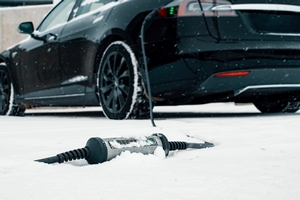

















|
|---|
|
Tail Lights: Fusion Powered Cars Publisher: The Crittenden Automotive Library Byline: Bill Crittenden Date: 1 January 2023 |

 Juice charging a Tesla in the snow. Juice charging a Tesla in the snow. |
The big Christmas freeze most of North America just endured exposed a weakness in the all-electric future lawmakers in California & New York envision. Charged batteries just don't hold the same amount of power in cold weather, and constantly running an electric heater takes a lot of what's left of that power to run.
This criticism is not just the usual coal rolling enthusiasts looking for an excuse to hate Nissan Leaf drivers, either. These were real electric vehicle owners complaining about the vehicles they bought. Cold weather battery performance is a real obstacle to EV adoption for people living in the Great Lakes region, the northern plains, and Canada.
This hasn't escaped the notice of the auto industry. Akio Toyoda says “People involved in the auto industry are largely a silent majority. That silent majority is wondering whether EVs are really OK to have as a single option. But they think it’s the trend so they can’t speak out loudly…The right answer is still unclear, we shouldn’t limit ourselves to just one option.”
Thankfully, a solution presented itself right before the cold weather crisis: on December 5th scientists at the U.S. National Ignition Facility initiated a nuclear fusion reaction that created more energy than it consumed. It proves that a fusion energy industry is possible, something scientists have been chasing since the 1950s.
There was such optimism that nuclear energy would be directly powering our cars that Ford created the Nucleon concept in 1957. But in a non-functioning, scale model form only.
Now we're optimistic that fusion power could run our vehicles indirectly. Near limitless, cheap electric power would end the “but it's just a longer tailpipe” argument against electric vehicles being recharged by fossil-fuel-derived electricity.
But that still leaves all the other problems we've experienced with electric vehicles: the pollution that would come from junking and replacing our entire national fleet of vehicles, replacing our entire fueling infrastructure, the likely bottleneck in converting to an all-EV fleet created by limits in lithium mining, international trade conflicts over rare earth minerals used in electric vehicle motors, the growth in the number of difficult-to-fight lithium EV battery fires, issues with roads & bridges that would come from increasing the average vehicle weight, to name the biggest ones off the top of my head.
We could keep gasoline, at 33.7 kWh of energy per gallon that can replenish 400+ miles of range in a couple of minutes, as merely a system of delivering fusion power from the reactor to the vehicle using our existing vehicles and fueling infrastructure.
Synthetic "electrofuels" or "eFuels" combine CO2 or carbon monoxide with hydrogen to create the hydrocarbon structures that make up motor fuels. But by definition "un-burning" hydrocarbons requires energy to be put into it instead of releasing it, and it will take a lot of energy to produce any meaningful amount of new fuel. As much as four times the energy gained from creating it by some estimates, but maybe with development the industry can improve on that.
It's currently an experimental product because electricity isn't free, which means it's more expensive than conventional oil-derived fuels. It's also not really clean & renewable as long as any of the energy used to create it comes from fossil fuels.
But given cheap and plentiful nuclear fusion power (still years away), we could suck tons of CO2 from the atmosphere and turn it into fresh synthetic gasoline. We could create a kind of "carbon cycle" where gasoline would become a renewable fuel made from the CO2 of previous fossil fuel use.
A fusion power reactor coupled to a synthetic fuel factory would remove carbon from the atmosphere and turn it back into very literally carbon-neutral gasoline. Aside from the environmental benefits, this can be done local to where it is most used to reduce transportation costs, and done in practically any country reducing the international political influence of oil.
Blunting the environmental impact of hydrocarbon fuel use would allow us to develop the electric automobile market more deliberately & naturally, letting it thrive where it can without forcing people in the coldest climates into dangerous situations. By developing the EV market more slowly we could avoid some of the lithium mining bottlenecks and political upheavals that normally happen when there are major shifts in millions of people's livelihoods.
Now it's just a matter of timing. How soon can commercial fusion power be developed? How soon can synthetic fuel production be ramped up? Will it happen before environmental catastrophes and the resulting societal upheaval make it more difficult to develop such huge new industries? Would those who stand to lose some of their wealth and power fight them effectively?
The answers are coming.
629.2
The Dewey Decimal System's designation for automobiles falls within the 629.2 range. This section is about Library Owner Bill Crittenden's personal collection of books, magazines, and miscellaneous papers, much of which is available for reference if it's not directly available on CarsAndRacingStuff.com.
A little later than expected, but The Indomitable Tin Goose: The True Story of Preston Tucker and His Car is now fully online. Even with Apple's OCR assistance, it took longer than expected, but creating fully edited and proofread (and Google-readable) transcriptions of texts is going to be increasingly important in the next phase of finding information on the internet.
December seems to be a quiet month for book sales, but the Half Price Books after-Christmas sale was good. William Crouse's Automotive Electrical Equipment from 1950 should go online eventually, even if it's a bit too complicated to fully transcribe the way the Tucker book was.
If only I had unlimited time, or a couple dozen people working for me...
At the HPB sale I did find an old paperback novel of sports car racing called The Black Tiger, but it was $40 on sale. Thankfully, in just last March a fully proofread and accurately transcribed version was posted to Project Gutenberg. So happy to see that's still going strong, and it saved me $40!
While they weren't any of my photos, this hobby of collecting and posting public domain photos online helped a publisher find some pictures of Ken Schrader that he could use for an upcoming book. I'll have to add that book to the collection when it comes out, it's always exciting to see the Library making a difference in the automotive history field.
History Beyond the Bumpers
The Crittenden Automotive Library includes information from all aspects of automotive transportation and competition. This section highlights interesting topics related to automobiles other than vehicles themselves.
One of the first new Subject indices is The Environment. It's actually returning from the very early days of the Library when I cut down on the number of Subject indices to try and simplify things.
This month I'm contemplating the future of the world's mix of internal combustion and electric vehicles. In passenger cars gasoline enjoyed a century of hegemony between the Ford Model T and the Tesla Model S, but in the 1800s it wasn't clear that gasoline would emerge as the most popular method of propulsion. In 1896 engineer Sir David Salomons thought it would be steam, but interestingly said about diesel: “The ideal heavy oil motor for light work has not yet appeared on the market. To volatilize or to spray the oil, a special form of carburetter, or some equivalent, is necessary, less simple in form than that required with the lighter spirits like benzine. Besides this, the exhaust gases have a very disagreeable smell. Many attempts have been made to scent the oil, but the success met with is somewhat doubtful.” I find it interesting that the diesel engine was knocked for its exahust smell in an era where the streets were literally lined with horse shit, and their proposed solution was to add some kind of tail pipe Air Wick to the car.
Modern diesel cars are pretty clean, but can you imagine an old '50s Bel Air puttering about, puffing out little clouds of rose scented diesel smoke each time it pulls away from a stop sign?
About The Crittenden Automotive Library
The Crittenden Automotive Library @ CarsAndRacingStuff.com, based in Woodstock, Illinois, is an online collection of information relating to not only cars, trucks, and motorcycles, but also the roads they drive on, the races they compete in, cultural works based on them, government regulation of them, and the people who design, build, and drive them. We are dedicated to the preservation and free distribution of information relating to all types of cars and road-going vehicles for those seeking the greater understanding of these very important elements of modern society, how automobiles have affected how people live around the world, or for the general study of automotive history and anthropology. In addition to the historical knowledge, we preserve current events for future generations.
The Library currently consists of over 868,000 pages of books, periodicals, and documents, over 54,000 individual articles, more than 18 days of video & 24 days of audio, more than 36,100 photographs & other images, and offline reference materials including 847 book volumes, over 1,200 magazines, and thousands of advertising brochures & documents.
